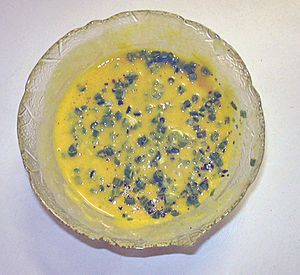Béarnaise sauce facts for kids
Béarnaise sauce (called Sauce béarnaise in French) is a delicious sauce. It's made with special butter (called clarified butter), egg yolks, and fresh herbs. Many people think of it as a "child" of another famous sauce called Hollandaise sauce. Both are important in fancy French cooking.
The main difference between Béarnaise and Hollandaise is their taste. Béarnaise sauce gets its flavor from ingredients like shallots, chervil, peppercorns, and tarragon. Hollandaise sauce, on the other hand, uses lemon juice for its flavor.
Béarnaise sauce looks light yellow and is smooth and creamy. It's often served with steak, making it a classic choice for many meals.
Contents
The Story Behind Béarnaise Sauce
Even though a similar recipe appeared in 1818, most people believe Béarnaise sauce was first made by a chef named Collinet. He was also famous for inventing puffed potatoes.
The sauce was likely served for the first time in 1836. This happened at the grand opening of a restaurant called Le Pavillon Henri IV. This restaurant was located in Saint-Germain-en-Laye, a town close to Paris, France.
The restaurant was named after Henry IV of France. He was a king who loved good food and was born in a region called Béarn. This connection to King Henry IV and his birthplace is why the sauce got its name.
How Béarnaise Sauce is Made
Making Béarnaise sauce can be a bit tricky, but it's very rewarding! A famous chef once said:
A Béarnaise sauce is simply clarified butter, an egg yolk, a shallot, a little tarragon vinegar. It takes years of practice for the result to be perfect.
The most common way to make Béarnaise sauce is using a method called a Bain-marie. This is like a double boiler, where a bowl sits over simmering water. This gentle heat helps cook the sauce slowly.
First, chefs create a special liquid called a "reduction." This reduction is made by boiling down vinegar with shallots, fresh chervil, fresh tarragon, and crushed peppercorns. This makes the liquid very flavorful and a bit sour, which is important for the sauce.
After the reduction is ready, it's often strained to remove the solid pieces. Then, egg yolks are slowly whisked into this flavored liquid over the gentle heat. Finally, melted clarified butter is slowly added while whisking constantly. This creates the smooth, creamy texture. Fresh tarragon and chervil are often added at the end for extra flavor.
Sauces Similar to Béarnaise
Béarnaise sauce has inspired several other delicious sauces. Here are a few:
- Sauce Choron: This is like Béarnaise sauce but without the tarragon or chervil. Instead, it has added tomato purée, which gives it a different color and taste. It's named after a person called Alexandre Étienne Choron.
- Sauce Foyot: This sauce is Béarnaise with a rich meat glaze (called Glace de Viande) added. This makes it even more savory.
- Sauce Colbert: This is a version of Sauce Foyot that also includes reduced white wine.
- Sauce Paloise: This is a fun twist on Béarnaise sauce. Instead of tarragon, it uses fresh mint for its flavor.
Why the Name Can Be Confusing
Sometimes, people mistakenly call this sauce Bernaise sauce. This makes it sound like it comes from Bern, the capital city of Switzerland. However, the sauce has nothing to do with Switzerland or Bern!
The name Béarnaise actually refers to the Béarn region in southwestern France. But here's another interesting fact: the sauce isn't traditionally from the Béarn region's cooking. Instead, the name honors Henry IV of France, who was born in Béarn. The restaurant where the sauce was first served was named after him, and he was often called "le Grand Béarnais" (The Great Béarnais).
What "À la Béarnaise" Means
You might see some recipes called "à la béarnaise" even if they don't come with Béarnaise sauce. This is because these recipes themselves have a connection to the Béarn region. This can sometimes add to the confusion about the sauce's name!
See also
 In Spanish: Salsa bearnesa para niños
In Spanish: Salsa bearnesa para niños


